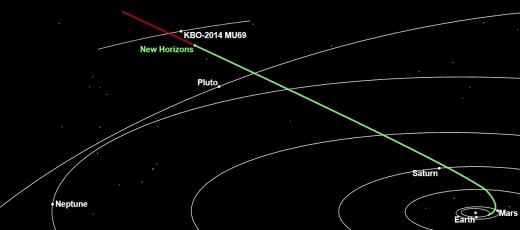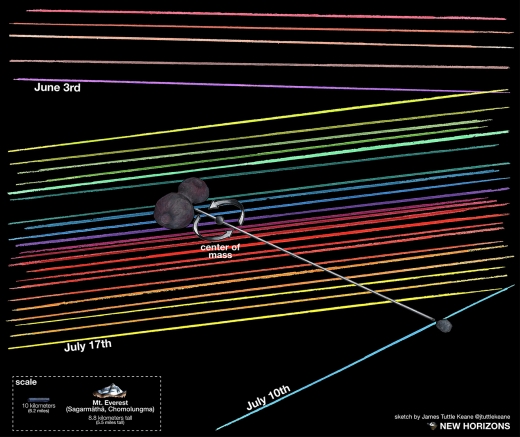We’re just a little more than a year away from New Horizons’ encounter with Kuiper Belt Object MU69. The spacecraft has now made its last trajectory correction of the cruise phase of its journey, following the 2015 flyby of Pluto/Charon, an adjustment performed to optimize science at destination. Both the Hubble instrument and the European Space Agency’s Gaia mission have supplied data that is now being used to tighten the parameters of the trajectory. Another course correction is possible in October of 2018 during the MU69 approach phase.

Image: The New Horizons spacecraft is about 483 million kilometers from 2014 MU69, the Kuiper Belt object it will encounter on Jan. 1, 2019. Credit: NASA/Johns Hopkins University Applied Physics Laboratory/Southwest Research Institute.
This update from JHU/APL tells us that closest approach is now scheduled for 0533 UTC, or 0033 EST on January 1, 2019, which should give many New Year’s partygoers something extra to stay up for. The course adjustment was performed to optimize visibility for the antennae of the Deep Space Network, which will reflect radar waves off the surface of MU69 in an experiment that, if successful, will help determine the reflectivity of its surface.
The 2.5-minute engine burn on December 9 thus sets a record for the farthest spacecraft course correction ever performed, at a distance of 6.1 billion kilometers. At this distance, radio confirmation took 5 hours and 41 minutes. The course was adjusted by approximately 151 centimeters per second, setting up a planned flyby distance of 3500 kilometers. New Horizons goes back into hibernation mode on December 21 and will remain in that mode until June.
Learning About the Target
Meanwhile, the occultation events of last June and July, which saw teams setting up telescopes in the shadow of the KBO as it passed in front of a star, have proved invaluable at assessing the shape of MU69, particularly the July 17 occultation, which produced information on the object’s size, shape and orbital characteristics. But it was data gathered by the Stratospheric Observatory for Infrared Astronomy (SOFIA) on July 10 that may be the most provocative, showing an abnormality in the occultation that could indicate a small moon.

Image: On three occasions in June and July 2017, New Horizons mission team members attempted to track a small, distant Kuiper Belt object, 2014 MU69, as it passed in front of a star – an event known as an occultation. The colored lines mark the path of the star as seen from different telescopes on each day; the blank spaces on those lines indicate the few seconds when MU69 blocked the light from the star. Scientists are using these observations to craft a picture of MU69 and any companion bodies. (Credit: NASA/Johns Hopkins University Applied Physics Laboratory/Southwest Research Institute/James Tuttle Keane).
Marc Buie (SwRI), a member of the New Horizons science team, updated the analysis of the MU69 occultations at the American Geophysical Union fall meeting in New Orleans.
“We really won’t know what MU69 looks like until we fly past it, or even gain a full understanding of it until after the encounter,” said Buie. “But even from afar, the more we examine it, the more interesting and amazing this little world becomes… A binary with a smaller moon might also help explain the shifts we see in the position of MU69 during these various occultations. It’s all very suggestive, but another step in our work to get a clear picture of MU69 before New Horizons flies by, just over a year from now.”
What we do know at this point is that MU69 is more than 6.5 billion kilometers from Earth and no more than 30 kilometers long if a single object, or if it is a binary, then each component is roughly 15-20 kilometers in diameter. Scientists are hopeful that the flyby will give us information about the earliest era of planet formation in the outer Solar System. In any case, the more we learn about it, the more intriguing this clearly worthwhile target becomes.
“The occultation effort that Marc Buie and his team led for New Horizons has been invaluable in opening our eyes to the very real possibilities that MU69 is both a lot more complex than anyone suspected, and that it holds many surprises for us at flyby on New Year’s Eve and New Year’s Day, 2019,” added New Horizons principal investigator Alan Stern, also from Southwest Research Institute. “The allure of its exploration is becoming stronger and stronger as we learn more and more about it. It’s just fantastic!”
As the mission continues, you can keep up with New Horizons’ position here.



Hi all. Does anyone know what efforts if any are being made for a potential second Transplutonian flyby?
I saw this one some time back: http://spacenews.com/new-horizons-planning-additional-extended-missions/
Thanks! That’s good news. I also found it interesting that the mission team will be updating the spacecraft’s software enabling it to perform onboard image processing thereby reducing the earthbound data stream.
Hard to believe we are already close to just a year away from the flyby. It seems like just yesterday we were getting the superb pictures of Pluto and Charon, making them worlds that were more than just a blur with uneven albedos.
Although I doubt I will even see it, one day the first images of exoplanets will be shown, replacing artist impressions, and later, high-resolution pictures sent back from our interstellar probes. The Solar system will then seem just like a backyard as we venture out to see the details of worlds around other stars. That will be momentous for those living to see those images.
Has anybody looked to see if the path of ‘Oumuamua will cause an occultation of a bright star? For that matter why has no one showed it’s path on star charts so amateur astronomers can monitor it for any outburst? Deep sky astrophotography can reach the magnitude level that ‘Oumuamua is at with relatively modest telescopes.
Less than one year now:
http://www.americaspace.com/2018/01/01/pluto-and-beyond-new-horizons-next-kuiper-belt-rendezvous-only-one-year-away/
How time flies and so do really fast sublight space probes.
Next Christmas in the Kuiper Belt
Next New Year’s Day, NASA’s New Horizons spacecraft will make a close flyby of a small object, or objects, in the Kuiper Belt. Jeff Foust previews the science, and the technical challenges, of the flyby.
http://www.thespacereview.com/article/3398/1
What happens after New Horizons completes that data downlink in late summer of 2020 isn’t clear yet. A few months earlier, Stern sounded upbeat about the odds of performing a flyby of another Kuiper Belt object, saying there was “a fighting chance” of such a flyby. At the AGU meeting in December, though, Stern sounded less optimistic.
“There is a small chance that we might find another object to fly by, but our fuel supplies are very low,” he said, “and so the great probability is this will be the last flyby for New Horizons. That said, we will certainly look.”
Even without another flyby, Stern said New Horizons has enough fuel, and power from its radioisotope thermoelectric generator, to operate into the mid-2030s and perhaps later. The spacecraft, he said, could continue to carry out planetary science research in the Kuiper Belt, and also serve as a platform for astrophysical and heliophysical observations.
“There’s a lot of good science to do,” he said. “I expect New Horizons will have a series of successful proposals to NASA over the years, and continue in the great tradition of the Pioneers and Voyagers to keep exploring further and further outwards.”
Correlated Asteroid Pairs After Encounters With An Unseen Planetary Body Beyond Neptune
https://sciencetrends.com/correlated-asteroid-pairs-encounters-unseen-planetary-body-beyond-neptune/
February 8, 2018
New Horizons Captures Record-Breaking Images in the Kuiper Belt
NASA’s New Horizons spacecraft recently turned its telescopic camera toward a field of stars, snapped an image – and made history.
The routine calibration frame of the “Wishing Well” galactic open star cluster, made by the Long Range Reconnaissance Imager (LORRI) on Dec. 5, was taken when New Horizons was 3.79 billion miles (6.12 billion kilometers, or 40.9 astronomical units) from Earth – making it, for a time, the farthest image ever made from Earth.
New Horizons was even farther from home than NASA’s Voyager 1 when it captured the famous “Pale Blue Dot” image of Earth. That picture was part of a composite of 60 images looking back at the solar system, on Feb. 14, 1990, when Voyager was 3.75 billion miles (6.06 billion kilometers, or about 40.5 astronomical units [AU]) from Earth. Voyager 1’s cameras were turned off shortly after that portrait, leaving its distance record unchallenged for more than 27 years.
LORRI broke its own record just two hours later with images of Kuiper Belt objects 2012 HZ84 and 2012 HE85 – further demonstrating how nothing stands still when you’re covering more than 700,000 miles (1.1 million kilometers) of space each day.
“New Horizons has long been a mission of firsts — first to explore Pluto, first to explore the Kuiper Belt, fastest spacecraft ever launched,” said New Horizons Principal Investigator Alan Stern, of the Southwest Research Institute in Boulder, Colorado. “And now, we’ve been able to make images farther from Earth than any spacecraft in history.”
Full article and historic images here:
http://pluto.jhuapl.edu/News-Center/News-Article.php?page=20180208
New Horizons explains why it is so much better suited to explore the Kuiper Belt than the Voyagers:
http://pluto.jhuapl.edu/News-Center/PI-Perspectives.php?page=piPerspective_02_28_2018
And for good measure, a blog post from 2014 on why NH was also better for exploring Pluto than the Voyagers, even though Pluto was on the original Grand Tour plan and Voyager would have been able to image all of Pluto in detail and not just one hemisphere as NH was forced to in 2015:
http://pluto.jhuapl.edu/News-Center/PI-Perspectives.php?page=piPerspective_06_23_2014
And, oh yeah, we would have seen what Pluto looked like in 1986 so that if NASA did decide to follow up with New Horizons, we would have had that much more information to fine tune the NH mission with and since we now know the surface of Pluto is not permanently frozen solid, we could have seen what had changed in the intervening decades and learned that much more about the system.
Of course if our society really had its priorities straight, we would already either have a Pluto probe orbiting it and depositing landers or on its way out there.
https://phys.org/news/2017-04-pluto-missionan-orbiter-lander.html
https://www.nasa.gov/feature/fusion-enabled-pluto-orbiter-and-lander
Review: Chasing New Horizons
New Horizons was not just the first spacecraft to fly by Pluto, it was also a triumph for a group of scientists who battled bureaucracies for decades to get the mission launched. Jeff Foust reviews a book co-authored by the mission’s principal investigator that provides the inside story on the mission.
Monday, April 30, 2018
http://thespacereview.com/article/3481/1
To quote:
Stern’s interest in a mission to Pluto dates back to the 1980s. Working on his doctorate at the University of Colorado—a return to academia after several years in industry—he wondered if he had missed out on the golden age of planetary exploration, now that Voyager 2 was performing its flybys of Uranus and Neptune. “I think I’m different from most people in our field in the extent to which I’m really inspired by exploration itself, independent of the science,” he said.
Scientists, though, didn’t share that view, arguing that any mission to Pluto needed to be justified by the science it could produce. Stern started to build up that “critical mass of support” among scientists, which became known as the Pluto Underground. The origin of what would become New Horizons, Stern and Grinspoon argue, was a dinner at an “unremarkable” Italian restaurant in Baltimore in May 1989, during a meeting of the American Geophysical Union. That conference featured a session on Pluto science, and Stern had also recently met with a NASA official who appeared willing to support a study of a Pluto mission. That dinner, recalled another attendee, was “the turning point where it all went from gee-whiz hallway conversations to a larger, more systemic plan of attack to try to accomplish something.”